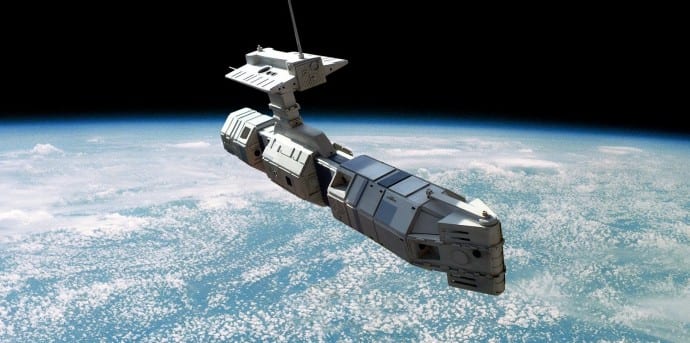If Russia can find the Rubles, they can use Nukes to fly to Mars in 45 days
Last week, Russia’s national nuclear corporation Rosatom announced that it is developing a nuclear engine that will reach Mars in a month and a half that would also have enough fuel to return home. However, Russia will be able to reach this goal only by 2025. But that has more to do with the country’s financial situation (not great) than the technical challenges of a nuclear engine.
Many of those challenges were resolved by the Soviet scientists by 1967, when they started launching fission-powered satellites. Americans had their own program, called SNAP-10A, which was launched in 1965. The nuclear thermal propulsion programs (Though the Soviets’ lasted into the 1980s) was prematurely rejected by both the countries. “Prematurely” because those fission systems were made for comparatively lightweight orbital satellites and not high-thrust, interplanetary vessels fattened with life support for human riders.
Nevertheless, “A nuclear contraption should not be too far off, not too complicated,” says Nikolai Sokov, senior fellow at the James Martin Center for Nonproliferation Studies in Monterey, CA. “The really expensive thing will be designing a ship around these things.”
One flavor of nuclear propulsion is nuclear thermal. No details were provided by about their system’s specs, but its announcement points at some kind of thermal fission. It means that the engine would produce heat by splitting atoms and use that heat to burn hydrogen or some other chemical. Burning stuff goes one direction, spaceship goes the other.
The principle isn’t too far from chemical propulsion. Thrust gets created when the fastest chemical rockets generate thrust by igniting one type of chemical (the oxidizer) to burn another (the propellant). Based on a metric called Specific Impulse, rocket scientists rate propulsion methods, chemical or otherwise. Robert Kennedy, a systems engineer for Tetra Tech in Oak Ridge, TN, and former congressional fellow for the US House of Representatives’s space subcommittee says, “Which means, if I have a pound of fuel, for how many seconds will that pound of fuel create a pound of thrust.”
For example, about 269 seconds of thrust in a vacuum gets generated when one pound of the chemical mixture powering the Space Launch System – NASA’s in utero rocket for the agency’s planned mission to Mars.
But the results of those two methods are completely different, as chemical rocketry has a catch-22. You need to pack more fuel, if you want to go faster or more farther. As a result, the rocket will be become more heavy due to the excess fuel that is packed, which in turn would require you to bring more fuel due to the heavy rocket.
In the end, which is why a year and a half is around the lower time limit for sending a chemically propelled, crewed mission to Mars due to the equation balancing thrust to weight plateaus. Also, this does not even consider the incredible cost of launching fuel—about $3,000 a pound. While it is expensive, the politics surrounding nuclear make it difficult to sell in America, so NASA is stuck with the Space Launch System (and its thirsty fuel tanks) for now.
The engines the Soviets and Americans were developing during the Space Race, on the other hand, had at least double a chemical rocket’s specific impulse. Modern versions could likely do even better. Which means spaceships would be able to carry a lot more fuel, and therefore fire their thrusters for a longer portion of the trip to Mars (bonus: artificial gravity!). Even better, a thermal fission spaceship would have enough fuel to decelerate, go into Martian orbit, and even return to Earth.
For inspiring space dreamers, a fission mission to Mars is great, but Russia’s planned engine could have practical, near-term applications. In order to stay in their ideal orbits, satellites need to fire their thrusters very often to keep them from crashing to Earth. Sokov thinks the main reason for developing a nuclear thermal engine would be to allow for more of these orbital corrections, thereby increasing a satellite’s working lifetime. Fission power would also give probes more maneuverability. “One civilian application is to collect all the space junk,” says Sokov. “You are free to think of other, perhaps not as innocent applications.”
Even though Russia has the will to go nuclear, it however lacks the sources. Rosatom which began its project in 2010 is expected to have a launch-ready vehicle by 2025, has estimated roughly 15 billion rubles on the project. This is about $700 million, which is freaking cheap for a 15-year long space project. In comparison, the rocket part of NASA’s Space Launch System is projected to cost nearly $10 billion.
The reason why Rosatom made its 6-weeks-to-Mars announcement last week may be because that the 15 billion rubles does not include the cost of launch. “Going public can serve a number of purposes, including getting funding, increasing visibility, things like that from politicians, readers, and others who would like this visionary thing,” says Sokov. By 2018, Rosatom plans to have a land-based test reactor.
If the Russian Federation is successful, they would not be stopped by international treaties, which only would be applicable to nuclear weapons. However, that does not mean the engine would be entirely secure. Not always are the things that are launched from rockets make it to space, as sometimes things in orbit may fall to Earth. In 1978, a nuclear-powered Soviet satellite crashed in northern Canada, pouring radioactive waste over nearly 50,000 square miles.
Resources: wired
